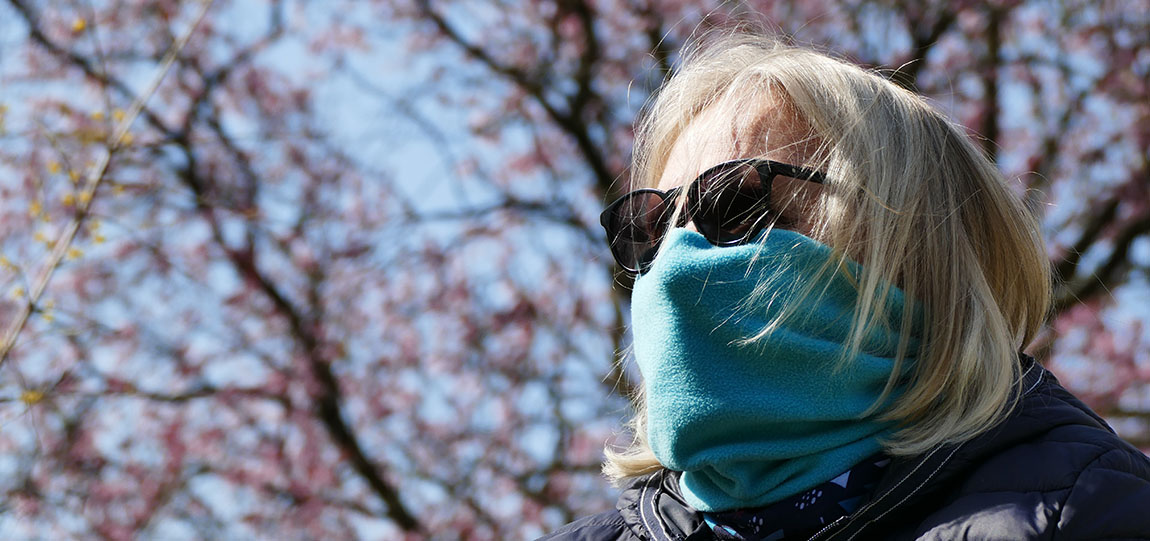A Public Health Professor’s Take on Masks
Here’s what you need to know about the CDC recommendation to cover your mouth and nose when in public places.By: Chrysan Cronin Wednesday, April 15, 2020 01:34 PM
 A woman in a makeshift mask. Photo by iStock.
A woman in a makeshift mask. Photo by iStock.Chrysan Cronin, assistant professor and director of public health at Muhlenberg, will be sharing her analysis of the COVID-19 pandemic on the College website. The information in this article was correct and current at the time of publication; scientific understanding of the virus as well as official guidelines are changing rapidly.
On April 3, the Centers for Disease Control and Prevention (CDC) recommended that all Americans wear masks in public places to slow the spread of COVID-19. But what’s the scientific basis for the recommendation, and how can we safely put it into practice?
What’s the difference between the different kinds of masks I’ve heard about?
N95 masks are FDA-approved and certified by the National Institute of Occupational Health and Safety (NIOSH) to ensure that the masks filter out at least 95 percent of particles measuring less than 0.3 microns. These masks are fitted properly to the face of the wearer and create a seal to minimize air entering from the sides or top at the nose. Healthcare workers need these masks, and they are in short supply. These masks are not what the CDC is recommending for the average person.
Surgical masks—the kind that you see many people wearing—are not subject to any type of FDA approval or certification. They do not filter or block very small particles, and they do not seal well around the face. They offer little to no protection of becoming infected for the wearer.
Cloth masks and other homemade versions of masks are similar to the surgical masks in that they offer little to no protection of becoming infected for the wearer. However, unlike surgical masks, they can be washed and worn again.
So why are we being told to wear cloth masks when we go out to the grocery store or other places?
The point of wearing the mask is not to protect yourself from getting infected. As I said above, neither surgical nor cloth masks will not protect you from the small viral particles. The pores in the fabric are too large to trap particles as small as the virus. In addition, these masks do not fit around the face in a way that seals air from entering the sides or top.
We also know that the virus can enter through the eyes. These masks do not cover the eyes, so there is a portal of entry for the virus that is unprotected. People wearing masks may think that they are being protected, but in reality, they are not. This gives them a false sense of security and may lead them to make riskier decisions.
The CDC suggestion for all of us to wear masks is to minimize the risk of an infected person spreading respiratory droplets to other people. Think about it like a stationary tissue over your mouth and nose that you don't have to hold. When you talk, sneeze or cough, the mask is there to intercept those droplets so that they can't land on someone else and infect them. Since some people who are infected with the virus do not show any symptoms, it seems reasonable that we should all be taking precautions to avoid exposing others to our respiratory secretions just in case we are one of those asymptomatic people.
What’s the right way to wear a mask?
It's important to understand how to wear a mask—do it incorrectly and you may put yourself in more danger of getting sick than you would if you weren’t wearing one.
Here are some mask-wearing tips:
- Try to wear a mask that fits your face snugly, but doesn't affect your breathing.
- Before you put on a mask, wash your hands. Then, put it on your face, adjust it and don't touch your mask or your face again until you’re ready to remove it. I have seen a number of people fidgeting with their masks, which means they are touching their faces, a potentially fatal mistake.
- Before removing your mask, wash your hands again. Also wash them after removing it.
- Wash cloth masks in hot water and soap immediately after using them, not only because of what others may have expelled on it, but also because your own respiratory secretions contain bacteria, yeast and other microorganisms that can live on the mask for a long time.
- Don't share your mask with anyone else unless it has been washed.
But the most important advice continues to be: STAY HOME! As much as possible, stay at home so you don't have to wear a mask (unless you or someone in your house is sick). We are flattening the curve because we are doing what we need to do to slow down the spread of this disease, which is avoiding other people.
